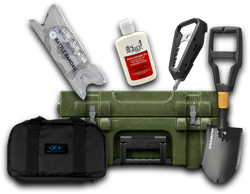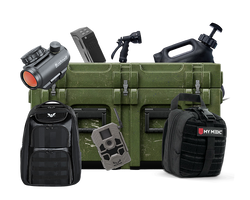
THINGS TO CONSIDER WHEN CONSTRUCTING A BUNKER
An underground survival bunker is a dream come true for any serious survivalist. We all know that heads of state and billionaires have emergency bunkers, but you and your family should have one as well. A survival bunker is one of the most sure-fire ways to protect your family in the case of an emergency of epic proportions. Your personal bunker is unlikely to be equipped with recliners and flat screens, we’ll leave that to the billionaires, but with proper planning and funds, you can create a backyard bunker capable of outlasting a zombie apocalypse or natural disaster.
Creating a bunker is no simple weekend project. This will require serious time and energy. While it will demand significant resources, the payoff is huge. Once completed, your bunker will be the perfect place to store your survival supplies – food, ammunition, medical kits, etc. Not to mention, you won’t have to worry about moving any of these once disaster strikes! Everything will be neatly stored in the bunker where you will be able to live for an extended period.
There are three primary considerations to take into account before beginning work on your bunker: location, excavation, and materials.
LOCATION
Building a bunker is a significant construction project and as such it is recommended that you plan everything out before breaking ground. Blueprints, permits, contracts, and floorplans are all important factors.
The first step is to obtain a building permit. You will likely need a half-acre of land for the permit to be approved, especially if you live in a busy area. Once you have a permit, you must pick a location. You will need to ensure that the selected area has the proper soil composition, is not too close to bedrock, and will not interfere with the water table. If the bedrock or water table is too close to the surface, you will not succeed in building a durable and safe bunker.
EXCAVATION
To dig a full-size bunker, you will need heavy machinery. You can rent equipment, or hire contractors to do it for you. This will consume a large portion of your budget, so make sure to price out options ahead of time. (Tip: If you live in a cold climate, DO NOT attempt this in the winter. Frozen ground will make excavation much slower and far more costly.)
Two things to think about before digging are air and water, both of which are things required to survive a disaster. You will need an air filtration system in order to ensure that you have fresh air in your bunker, allowing you to survive environments as harsh as those during a nuclear fallout. As you’re excavating, you will need to leave room for the air vents. The next consideration is your water source. You have a few options in terms of water source: water tanks, well, or rainwater harvest. Water tanks are the easiest, but they limit the length of time you can survive in your bunker. Digging further beneath the bunker to create a water well is the most sustainable option, but it requires more permits and funds. Alternatively, you can create a rainwater harvest system to collect and filter your drinking water.
MATERIALS
The material used to line your bunker depends on your budget. You can line it with tempered steel, but it will cost a fortune. Other, more cost-effective options include metal sheeting, bricks, cinder blocks, or concrete. Metal sheets welded together create a strong, water-resistant barrier that is preferred over other options. But, if you cannot find a reasonable deal on metal sheeting, bricks, cinder blocks, and concrete have their own advantages. Bricks and cinder blocks are cheap, sturdy, and great insulators. Concrete is the least expensive option and the fastest to install. Whichever material you choose, take precautions to ensure that your final bunker will be completely waterproof, as moisture is the greatest threat to stored survival supplies.
If, after looking into planning and finances of building your own DIY bunker, you would prefer to spend more to have it made professionally, you can pay a number of different companies to have a pre-made emergency bunker installed.
No matter how you choose to build it, an emergency bunker will allow you and your family to survive any form of disaster – natural or man-made. This investment will not only provide peace of mind knowing you will be safe in an emergency, but it will also act as a designated space to securely store all of your important survival supplies and gear.
Share this article







